Related Research Articles
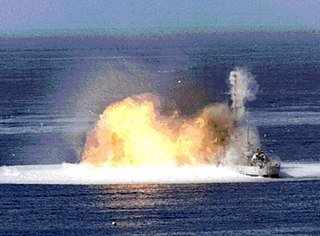
A thermobaric weapon, aerosol bomb, or vacuum bomb is a type of explosive that uses oxygen from the surrounding air to generate a high-temperature explosion. In practice, the blast wave typically produced by such a weapon is of a significantly longer duration than that produced by a conventional condensed explosive. The fuel–air explosive is one of the best-known types of thermobaric weapon.
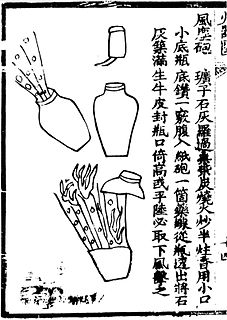
A bomb is an explosive weapon that uses the exothermic reaction of an explosive material to provide an extremely sudden and violent release of energy. Detonations inflict damage principally through ground- and atmosphere-transmitted mechanical stress, the impact and penetration of pressure-driven projectiles, pressure damage, and explosion-generated effects. Bombs have been utilized since the 11th century starting in East Asia.

A depth charge is an anti-submarine warfare (ASW) weapon. It is intended to destroy a submarine by being dropped into the water nearby and detonating, subjecting the target to a powerful and destructive hydraulic shock. Most depth charges use high explosive charges and a fuze set to detonate the charge, typically at a specific depth. Depth charges can be dropped by ships, patrol aircraft, and helicopters.
A bunker buster is a type of munition that is designed to penetrate hardened targets or targets buried deep underground, such as military bunkers.
The Mark 82 is an unguided, low-drag general-purpose bomb, part of the United States Mark 80 series. The explosive filling is usually tritonal, though other compositions have sometimes been used.

Incendiary weapons, incendiary devices, incendiary munitions, or incendiary bombs are weapons designed to start fires or destroy sensitive equipment using fire, that use materials such as napalm, thermite, magnesium powder, chlorine trifluoride, or white phosphorus. Though colloquially often known as bombs, they are not explosives but in fact are designed to slow the process of chemical reactions and use ignition rather than detonation to start or maintain the reaction. Napalm for example, is petroleum especially thickened with certain chemicals into a 'gel' to slow, but not stop, combustion, releasing energy over a longer time than an explosive device. In the case of napalm, the gel adheres to surfaces and resists suppression.

A shell is a payload-carrying projectile that, as opposed to a solid round shot, contains an explosive, incendiary, or other chemical filling, though modern usage sometimes includes large solid kinetic projectiles properly termed shot. Solid shot may contain a pyrotechnic compound if a tracer or spotting charge is used. Originally it was called a bombshell, but "shell" has come to be unambiguous in a military context.

A blockbuster bomb or cookie was any of several of the largest conventional bombs used in World War II by the Royal Air Force (RAF). The term blockbuster was originally a name coined by the press and referred to a bomb which had enough explosive power to destroy an entire street or large building through the effects of blast in conjunction with incendiary bombs.
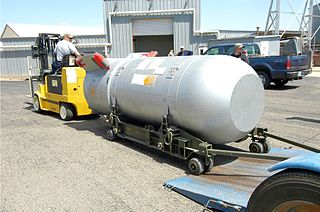
The Mk/B53 was a high-yield bunker buster thermonuclear weapon developed by the United States during the Cold War. Deployed on Strategic Air Command bombers, the B53, with a yield of 9 megatons, was the most powerful weapon in the U.S. nuclear arsenal after the last B41 nuclear bombs were retired in 1976.

The "Grenade, Hand, Anti-Tank No. 74", commonly known as the S.T. grenade or sticky bomb, was a British hand grenade designed and produced during the Second World War. The grenade was one of a number of ad hoc anti-tank weapons developed for use by the British Army and Home Guard after the loss of many anti-tank guns in France after the Dunkirk evacuation.
The Pine Bluff Arsenal (PBA) is a US Army Joint Munitions Command installation located in unincorporated Jefferson County, Arkansas, just northwest of the city of Pine Bluff. PBA is one of nine Army installations in the United States that stored chemical weapons. PBA supplies specialized production, storage, maintenance and distribution of readiness products, and delivers technical services to the Armed Forces and Homeland Security. PBA also designs, manufactures and refurbishes smoke, riot control, and incendiary munitions, as well as chemical/biological defense operations items. It serves as a technology center for illuminating and infrared munitions and is also the only place in the Northern Hemisphere where white phosphorus munitions are filled. Its Homeland Security mission includes first-responder equipment training and surveillance of pre-positioned equipment.
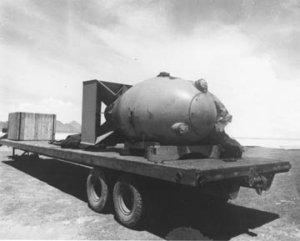
Pumpkin bombs were conventional aerial bombs developed by the Manhattan Project and used by the United States Army Air Forces against Japan during World War II. It was a close replication of the Fat Man plutonium bomb with the same ballistic and handling characteristics, but it used non-nuclear conventional high explosives. It was mainly used for testing and training purposes, which included combat missions flown with pumpkin bombs by the 509th Composite Group. The name "pumpkin bomb" was the term used in official documents from the large, fat ellipsoidal shape of the munition casing instead of the more usual cylindrical shape of other bombs, intended to enclose the Fat Man's spherical "physics package".

An anti-handling device is an attachment to or an integral part of a landmine or other munition such as some fuze types found in general-purpose air-dropped bombs, cluster bombs and sea mines. It is designed to prevent tampering or disabling, or to target bomb disposal personnel. When the protected device is disturbed, it detonates, killing or injuring anyone within the blast area. There is a strong functional overlap of booby traps and anti-handling devices.
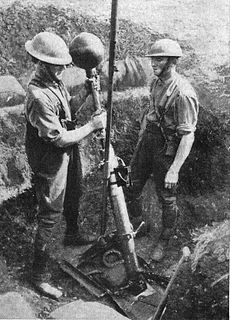
The 2 inch medium trench mortar, also known as the 2-inch howitzer, and nicknamed the "toffee apple" or "plum pudding" mortar, was a British smooth bore muzzle loading (SBML) medium trench mortar in use in World War I from mid-1915 to mid-1917. The designation "2-inch" refers to the mortar barrel, into which only the 22-inch bomb shaft but not the bomb itself was inserted; the spherical bomb itself was actually 9 inches (230 mm) in diameter and weighed 42 lb (19 kg), hence this weapon is more comparable to a standard mortar of approximately 5-6 inch bore.
In military munitions, a fuze is the part of the device that initiates function. In some applications, such as torpedoes, a fuze may be identified by function as the exploder. The relative complexity of even the earliest fuze designs can be seen in cutaway diagrams.

The M55 rocket was a chemical weapon developed by the United States in the 1950s. The United States Army produced both Sarin and VX unitary warheads for the M55.

The SC 1000 was a large air-dropped general-purpose thin-cased high explosive demolition bomb used by Germany during World War II. Weighing more than 1,000 kg (2,200 lb), it was nicknamed the Hermann by the Germans in reference to the portly Luftwaffe commander, Hermann Göring.
A contact fuze, impact fuze, percussion fuze or direct-action (D.A.) fuze (UK) is the fuze that is placed in the nose of a bomb or shell so that it will detonate on contact with a hard surface.

The Cooper bomb was a British 20 pounds (9 kg) bomb used extensively in World War I, it was the first high explosive bomb to be adapted by the Royal Flying Corps.

The Mortier de 75 modèle 1915 Schneider was a French trench mortar designed and built by Schneider that saw action with the French and Belgian Army during the First World War.
References
- 1 2 3 4 5 6 Martel, René (2007). Suddaby, Allen; Gordon, Martin (eds.). French Strategic and Tactical Bombardment Forces of World War I. Lanham (Md.): The Scarecrow Press. pp. 103–105. ISBN 978-0-8108-5662-2.
- ↑ Sanford, P. Gerald (1906). Nitro-Explosives: A Practical Treatise:Concerning the Properties, Manufacture, and Analysis of Nitrated Substances, Including the Fulminates, Smokeless Powders, and Celluloid. London. Retrieved 3 August 2015.
- ↑ "Save3DZoom 1-Nitronaphthalene" . Retrieved 3 August 2015.